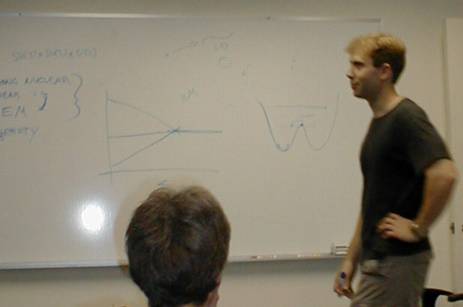Search this Site







From the Big Bang to Big Branes:
Swanson Describes the Latest in Cosmology
By Steve Bartlett
In the beginning of the Universe, there were no stars, no planets, no galaxies, no natural forces, or even empty space or time. There was simply energy, super concentrated into one infinitesimal place. And in the blink of an eye, that energy exploded into the Big Bang. A short time later, that energy created the fabric of space and, in the process, a myriad of potential Universes were born, each slightly different from the rest. Ian Swanson, lecturer from the California Institute of Technology, discussed the current theories in cosmology in a talk to
 |
| Ian Swanson Explains Brane Theory to |
In those first few moments of space and time, the four fundamental forces of nature (electromagnetism, gravity, and the strong and weak nuclear forces) were indistinguishable from one another, creating an infinitely varied mix of forces, matter, and energy. According to Swanson, modern physics is exploring what happened at that point and working to generate a coherent theory to unify these forces.
Swanson showed his audience the physics “family tree” depicting how our understanding of nature has grown and evolved from Isaac Newton’s theories of mechanics and gravity to quantum mechanics and relativity at the beginning of the twentieth century, and then on to quantum field theory, string and superstring theory, supersymmetry, and Brane theory over the past few years.
The far-ranging talk included a description of the Standard Model, which integrates three of the fundamental forces (electromagnetism and the strong and weak nuclear forces) in time and space and the problems with trying to mesh this model with gravity. Swanson went on to explain the dark matter problem, wherein astronomers discovered that the rotation rates of distant galaxies were far higher than could be accounted for by the mass of the visible stars. At the rotation rates measured, the galaxies would fly apart. Researchers theorized that there was additional matter, dark matter, that exerted a gravitational influence on the galactic matter but was otherwise undetectable with our instruments.
The Caltech researcher described how particles could be depicted as having a path in three spatial dimensions and time. The path that a particle takes is its string and these strings have ends and mass, as well as fundamental oscillation modes, like strings on a violin. The ends of the strings, known as Branes, are, according to Swanson,
where the interesting things happen in the Universe.
Copyright © 1998-2005 Organization for the Advancement of Space Industrialization and Settlement. All Rights Reserved.